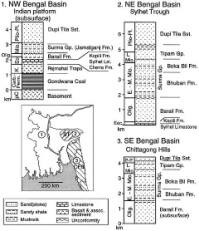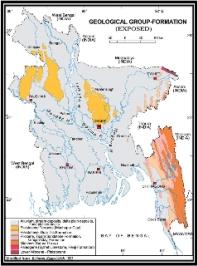Special Program for International Students
GRADUATE COURSE IN EARTH SCIENCE
& GEOENVIRONMENTAL SCIENCE
Current MEXT students
Dhiman Kumer Roy (Bangladesh)
Email: dhimans14 @yahoo.com
Thesis title: Geochemical evolution of the NW part (Province 1) of the Bengal Basin in relation to its provenance and the erosional history of the Himalaya.
Supervisor: Assoc. Prof. B. P. Roser (2009-2012).
The Bengal Basin is located at the junction between the Indian, Asian and Burmese lithospheric plates, covering most of Bangladesh and part of the Indian continent. The Bangladesh part of the basin has been divided into three distinct geotectonic provinces. These are: I) A passive to extensional cratonic margin in the west, and the stable shelf province in the NW part of Bangladesh (Province 1); II) Central deep basin (Province 2, Surma Basin), and III) A subduction-related orogen in the east, the Chittagong-Tripura Fold Belt (CTFB) (Alam et al. 2003). Each province varies in their facies and potential provenance (Reimann, 1993). The distinctive nature of the different provinces in relation to sedimentology, basin fill history, tectonics and provenance nature is thus relevant for geological studies of the entire Bengal Basin. My current study focuses on the NW stable shelf part of the Bengal basin (Province 1), and examines the Tertiary and Gondwana successions in the area from petrographic and geochemical viewpoints, based a stratigraphic framework. This will complete an overview of geochemical provenance signatures, tectonic settings, and weathering histories in the three major geological provinces of Bangladesh.
Specific objectives of my study:
- To characterize the mineralogical composition and petrographic classification of Province 1 sandstones and mudstones and stratigraphic variation within the succession, based on modal composition and clay mineralogy.
- Geochemical characterization of Province 1 sandstones and shales at a formational scale and their geochemical variation.
- Determination of source rock characteristics, tectonic setting of deposition, weathering intensity and the effect of sedimentary processes.
- Determine the effects of climate and influence of foreland basin dynamics on the geochemical compositions of the sediments in relation to the erosional history of the Himalayan orogen.
- Previous and new geochemical and petrographical data will be interpreted in the light of the the findings of Najman et al. (2008), to gain a better understanding of Province 1 provenance, tectonic setting, weathering and the erosional history of the Himalaya.
- Compare petrographic and geochemical data for coeval Tertiary formations in Provinces 1, 2 and 3.



